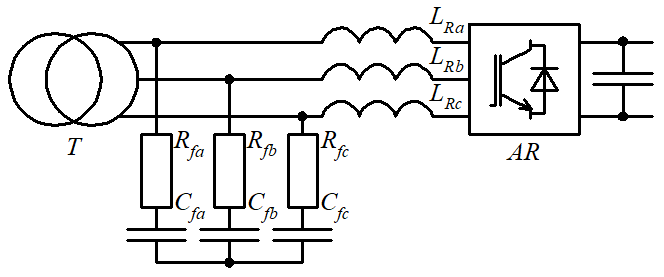Determination of the input filter parameters of the active rectifier with a fixed modulation frequency
DOI:
https://doi.org/10.20998/2074-272X.2022.4.03Keywords:
input filter, active rectifier, autonomous voltage inverter, output filter, Q factor, pulse-width modulation, total harmonic distortionAbstract
Goal. Development of a methodology for calculating the parameters of the active rectifier-voltage source input filter operating with a fixed modulation frequency to ensure electromagnetic compatibility with the supply network acceptable by standards at minimum values of the input inductance and checking its main characteristics on a mathematical model. Methodology. The authors have developed a methodology for calculating the parameters of the input filter of an active rectifier-voltage source. The calculation results are verified on the constructed mathematical model of a frequency converter, the scheme of which is an active rectifier and an autonomous voltage inverter. A series of experiments was carried out on a mathematical model to study the dependence of the total harmonic distortion of current and mains voltage on the value of the input inductance for various parameters of the input filter. Results. The structure and calculation procedure the input filter of an active rectifier operating with a fixed modulation frequency are proposed. The simulation results showed that the inclusion of a filter at the input of the active rectifier significantly improves its electromagnetic compatibility with the supply network in the entire range of variation of the input inductance of the circuit and makes it possible to achieve the values of the total harmonic distortion permissible by the norms. Originality. A structure and a calculation procedure the input filter of an active rectifier-voltage source operating with a fixed modulation frequency are proposed. Practical significance. The dependencies obtained in the article allow us to evaluate the relationship between the parameters of the filter elements and its characteristics among themselves and come to a compromise between them when designing a scheme for specific technical conditions.
References
Bie Y., Li Y., He G., Zhang X. PWM rectifier impedance modelling and analysis. IOP Conference Series: Earth and Environmental Science, 2021, vol. 675, no. 1, p. 012064. doi: https://doi.org/10.1088/1755-1315/675/1/012064.
Pandurangan R., Kaliannan P., Shanmugam P. Effects of Current Distortion on DC Link Inductor and Capacitor Lifetime in Variable Frequency Drive Connected to Grid With Active Harmonic Filter. IEEE Transactions on Industry Applications, 2021, vol. 57, no. 1, pp. 492-505. doi: https://doi.org/10.1109/TIA.2020.3028555.
Xiao X., Zhang Y., Wang J., Du H. An Improved Model Predictive Control Scheme for the PWM Rectifier-Inverter System Based on Power-Balancing Mechanism. IEEE Transactions on Industrial Electronics, 2016, vol. 63, no. 8, pp. 5197-5208. doi: https://doi.org/10.1109/TIE.2016.2558138.
Shklyarskiy J.E., Bardanov A.I. Novel Approach to Active Rectifier Control During Voltage Dips. 2018 International Multi-Conference on Industrial Engineering and Modern Technologies (FarEastCon), 2018, pp. 1-5. doi: https://doi.org/10.1109/FarEastCon.2018.8602678.
Krylov D., Kholod O., Radohuz S. Active rectifier with different control system types. 2020 IEEE 4th International Conference on Intelligent Energy and Power Systems (IEPS), 2020, pp. 273-278. doi: https://doi.org/10.1109/IEPS51250.2020.9263226.
Krylov D.S., Kholod O.I. The efficiency of the active controlled rectifier operation in the mains voltage distortion mode. Electrical Engineering & Electromechanics, 2021, no. 2, pp. 30-35. doi: https://doi.org/10.20998/2074-272X.2021.2.05.
Wai R.-J., Yang Y. Design of Backstepping Direct Power Control for Three-Phase PWM Rectifier. IEEE Transactions on Industry Applications, 2019, vol. 55, no. 3, pp. 3160-3173. doi: https://doi.org/10.1109/TIA.2019.2893832.
He H., Si T., Sun L., Liu B., Li Z. Linear Active Disturbance Rejection Control for Three-Phase Voltage-Source PWM Rectifier. IEEE Access, 2020, vol. 8, pp. 45050-45060. doi: https://doi.org/10.1109/ACCESS.2020.2978579.
Goncharov Y.P., Panasenko M.V. Statychni peretvoriuvachi tiahovoho rukhomoho skladu [Static converters of traction rolling stock]. Kharkiv, NTU «KhPI» Publ., 2007. 192 p. (Ukr).
IEEE Std 519-2014. IEEE Recommended Practice and Requirements for Harmonic Control in Electric Power Systems. 2014, 29 p. doi: https://doi.org/10.1109/IEEESTD.2014.6826459.
Bose B.K. Power semiconductor devices. In Power Electronics and Motor Drives, 2021, pp. 59-109. Elsevier. doi: https://doi.org/10.1016/B978-0-12-821360-5.00002-6.
Krylov D., Kholod O. The influence of the input inductance on the qualitative indicators of active controlled rectifier. Bulletin of the National Technical University «KhPI» Series: New Solutions in Modern Technologies, 2021, no. 1(7), pp. 18-23. doi: https://doi.org/10.20998/2413-4295.2021.01.03.

Downloads
Published
How to Cite
Issue
Section
License
Copyright (c) 2022 D. S. Krylov, O. I. Kholod

This work is licensed under a Creative Commons Attribution-NonCommercial 4.0 International License.
Authors who publish with this journal agree to the following terms:
1. Authors retain copyright and grant the journal right of first publication with the work simultaneously licensed under a Creative Commons Attribution License that allows others to share the work with an acknowledgement of the work's authorship and initial publication in this journal.
2. Authors are able to enter into separate, additional contractual arrangements for the non-exclusive distribution of the journal's published version of the work (e.g., post it to an institutional repository or publish it in a book), with an acknowledgement of its initial publication in this journal.
3. Authors are permitted and encouraged to post their work online (e.g., in institutional repositories or on their website) prior to and during the submission process, as it can lead to productive exchanges, as well as earlier and greater citation of published work.




